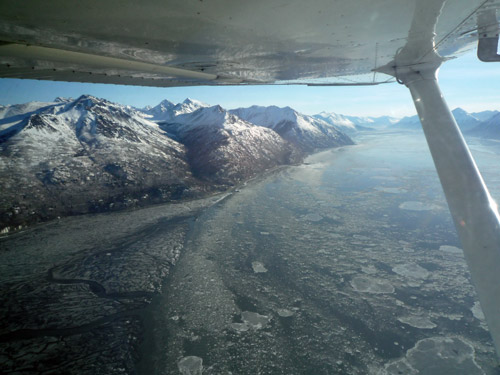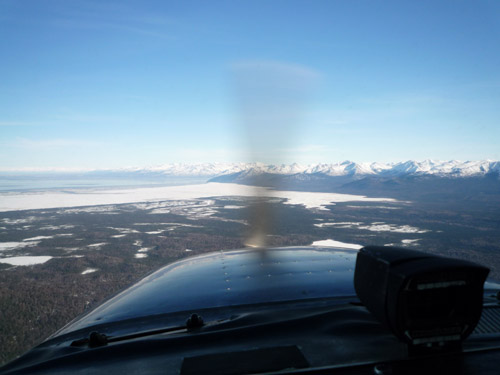Aircraft: C172 N52654
Flight Time: 1.5 hours
Total Hours: 22.9
Lesson 19 was scheduled for my night cross country. Riding the high of having done my first cross country two days previous, I was looking forward to a night flight to Talkeetna. The weather during the day looked totally fine, and at around 5:00 PM, two hours before my lesson, I sat down to check the weather.
To my surprise, it said 1/2 mile visibility and freezing fog in Talkeetna. A big low pressure system was moving northwest of Anchorage and the radar showed a large band of precipitation moving across the entire Kenai Peninsula, as well as snow to the north. However, the forecasts were calling for lifting ceilings and watching the radar loop, it was apparent that the snow would blow through the area before my lesson. The question was, what would follow.
When I got to the airport, I checked the current conditions with my instructor and after calling the Kenai FSS, we made the decision to fly to Kenai. It looked like the all the cloud ceilings had lifted enough to make for adequate VFR conditions, so we preflighted the plane and got ready to go.
The wind started to pick up as we called for clearance, and so I got in some good crosswind taxi practice as we headed over to runway 16. We encountered a little bit of snow as we climbed and headed over South Anchorage, but things were still looking good at that point.
The air got bumpy as we crossed over the Turnagain Arm. Really bumpy. Being lined with mountains on both sides, the wind can really blow through there with much more velocity than in the open areas around the Anchorage bowl. About halfway across, the turbulence became severe, and I listened as my instructor gave me tips on reducing power and keeping the airplane straight and level as we were being tossed around in dark. I remained calm, knowing that as bad as it was, there it would lessen as we reached the other side of the arm. And we could see the lights of Kenai off in the distance, so it seemed as if this would be the worst of it.
I knew that there were mountains straight ahead to the south, and so I watched carefully to the VOR needle so that I knew when to make my turn towards the Kenai VOR. Since I could see the lights of Kenai and the faint outline of Chickaloon Bay off to the right, my instructor suggested that I just go ahead and make a slow turn towards that heading. The turbulence remained severe all the way across, and even if we had decided to turn around, the smart thing would be to continue crossing and then turn around on the other side.
It did get smooth again as soon as we crossed and so I loosened my grip on the yoke a bit as we continued our course to Kenai. I cross checked the NAPTO VOR intersection with the radio and started tracking to the Kenai VOR, realizing that our slow groundspeed of around 60kt, as indicated on the DME, meant that we were flying into about a 30kt headwind.
At about 25nm from Kenai, we started seeing some low scattered clouds up ahead, and dialing into the Kenai AWOS, the report indicated a scattered level at 1,000 feet. Shortly after, my instructor told me to make a 180 and looking out ahead of us, I saw a faint blanket of light gray clouds about a thousand feet below us. Unfortunately, this meant that we could not continue, and so we turned and headed back towards Merrill. We called the FSS and amended our flight plan and reported the severe turbulence over the Arm, and then called up Anchorage Approach to get flight following on the way back.
The turbulence was not as strong fling in the other direction over the Turnagain Arm, probably because we now had a 30kt tailwind, but it was still pretty choppy. Again, I used smooth, easy control movements and kept a hand on the throttle as we turned north, and eventually, we made it back over Potter’s Marsh where the air got smoother. We called up Merrill Tower, got clearance to land on RWY 16, and then made our descent towards the field. My approach landing was pretty good, despite the strong headwind coming straight down the runway, and my instructor kept a hand on the yoke as we brought the plane down onto the runway. As we landed, the tower guy told us “good job.” I’ll take that and give myself a pat on the back for landing in difficult conditions. My instructor told me that I did an excellent job as well, and as we put the plane back in the hangar, he even told the owner of the flight school how well I did up there- that felt good.
Unfortunately, since we didn’t land at Kenai, the cross country didn’t count, and I’ll have to redo it. It’s a bummer indeed, but on the other hand, I got very good experience learning how to handle the aircraft in really turbulent air and a practical lesson in judgement and knowing when to run away. Also, learned more about how the weather behaves in and around this area.


